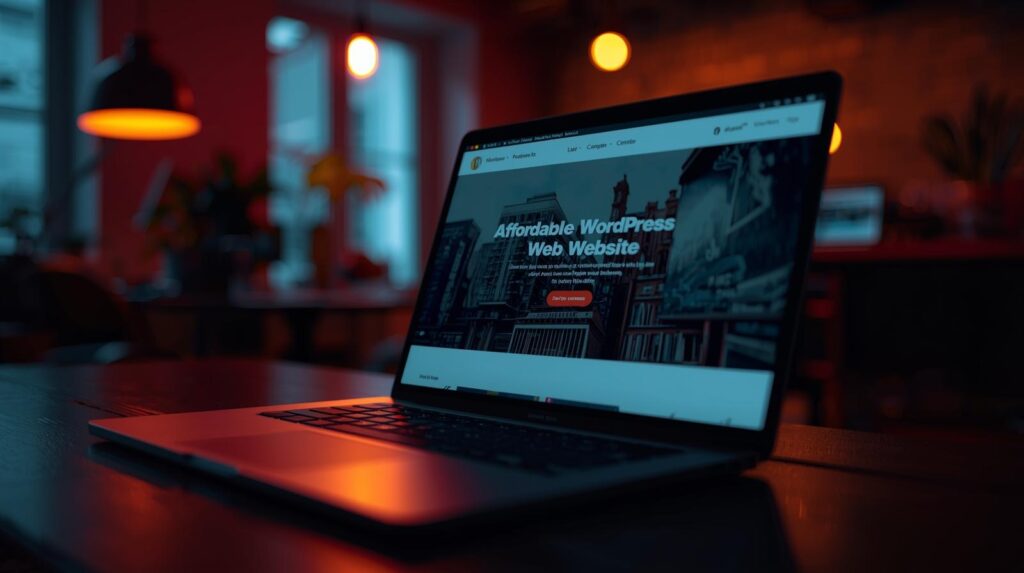How to Get an Affordable WordPress Website in 2025
Introduction
In our current digital age, every business, hobby, or personal project needs a website. WordPress is considered one of the best platforms to create an affordable and functional site. From blogs and e-commerce stores to portfolios, the WordPress platform has the powerful tools you need at your fingertips!
This 2025 guide will help you get an affordable WordPress website covering hosting, design tips, power-user hacks, and hidden cost pitfalls.

Why WordPress is the Top Choice for Budget Websites
Open-Source and Free to Use
The main reason why WordPress is perfect for budget website creation is because it’s open-source software. That means it’s free to download and use no licensing fees! You only need a domain name and hosting plan to start.
Huge Collection of Free Themes and Plugins
WordPress also has a large library of free themes and plugins. Whether you want a blog, e-commerce store, or portfolio, you can find free tools for:
- SEO optimization
- Security
- Performance improvements
Planning Your WordPress Website for Maximum Savings
Define Clear Goals and Features
Decide whether you need a blog, business site, or online store. Having clarity saves money by avoiding unnecessary premium tools.
Sketch a Simple Wireframe
A wireframe (blueprint of your website layout) helps identify what’s necessary, keeping you from overspending on extra features.
Choosing the Right Affordable Hosting Provider
Shared Hosting vs. Managed WordPress Hosting
- Shared Hosting: Cheapest, best for beginners and small websites.
- Managed Hosting: More expensive but optimized for WordPress, with better support and speed.
Best Budget Hosting Companies in 2025
- Bluehost: Affordable and beginner-friendly.
- SiteGround: Reliable performance with low-cost managed WordPress plans.
- Hostinger: Very budget-friendly with excellent speed.
Selecting a Free or Budget-Friendly WordPress Theme
Top Free Themes That Look Premium
- Astra: Lightweight and flexible.
- OceanWP: Great design and page builder compatibility.
- Neve: Minimalist and stylish.
Things to Look for in a Budget Theme
Choose themes that are
- Responsive (mobile-friendly)
- SEO-optimized
- Easy to customize
Installing Essential Free Plugins
Must-Have Plugins for Performance and Security
- Yoast SEO: Helps optimize your site for search engines.
- WP Super Cache: Improves speed with caching.
- Wordfence Security: Protects your website from attacks.
Free Alternatives to Paid Plugins
Instead of expensive builders, use Gutenberg (the free WordPress block editor) or Elementor Free for drag-and-drop designing.
Hiring Affordable WordPress Developers
Where to Find Budget Freelancers
- Upwork
- Fiverr
- Freelancer
Tips for Hiring Without Breaking the Bank
- Hire for small tasks (like theme customization).
- Choose hourly rates over fixed packages.
- Pick developers with good reviews and portfolios.
DIY Website Building: Save Money by Doing It Yourself
Beginner-Friendly WordPress Tutorials
- WPBeginner (step-by-step guides)
- YouTube tutorials
- WordPress forums
Best Free Tools to Help You Design
- Canva: Free logos and graphics.
- Unsplash: Free images.
- Elementor Free: Drag-and-drop design tool.
How to Get a Cheap Yet Professional Logo
Free Logo Makers and Tools
- Hatchful by Shopify
- Canva Logo Maker
- Look
Hiring a Budget Designer
Affordable logo design is possible on Fiverr or 99designs.
Reducing Ongoing Website Costs
Smart Choices to Avoid Future Expenses
- Choose long-term hosting plans.
- Update themes and plugins regularly.
- Use free backup plugins.
Subscription vs. One-Time Payment Plugins
Prefer one-time payment plugins if you need premium features.
Best Affordable E-Commerce Solutions for WordPress
Free WooCommerce Extensions
WooCommerce is free and allows you to add:
- Payment gateways
- Shipping options
- Inventory tools
Budget-Friendly Payment Gateways
- PayPal: No monthly fees.
- Stripe: Low-cost and integrates seamlessly.
How to Maintain Your Website on a Budget
Easy Maintenance Tips for Non-Techies
- Use free tools like Broken Link Checker.
- Update content regularly.
- Back up your site with UpdraftPlus (free).
Common Mistakes That Increase Costs
- Buying expensive themes/plugins you don’t need.
- Ignoring updates and maintenance, which leads to costly repairs.
Upgrading Later: Scaling Without Overspending
When to Invest in Premium Features
Only buy premium plugins/themes when your site’s needs grow.
Affordable Ways to Scale
- Upgrade hosting gradually.
- Add functionality step by step.
Hidden Costs to Watch Out for in 2025
- Domain renewals
- SSL certificates
- Hosting upgrades
Final Thoughts on Building a Budget WordPress Website
With careful planning, free tools, and smart choices, you can build a professional WordPress website on a budget in 2025. Focus on free themes, plugins, and tutorials, and only invest in premium options when necessary.

FAQs
1. Is WordPress really free?
Yes! WordPress itself is free. You only pay for hosting, a domain, and optional premium tools.
2. Can I create a professional website without a developer?
Absolutely. With free themes, plugins, and tutorials, you can build a professional site yourself.
3. How can I avoid hidden costs?
Plan your needs carefully, choose affordable hosting, and avoid buying unnecessary premium tools.
